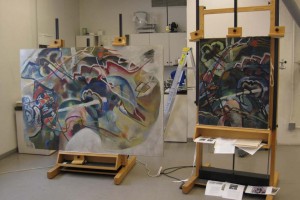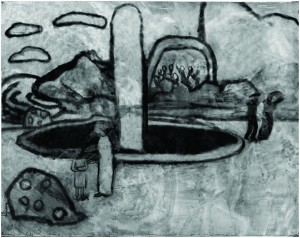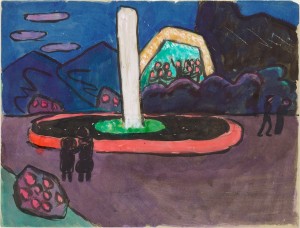 In preparation for an exhibit dedicated to Wassily Kandinsky’s 1913 oil painting Painting With White Border, the Guggenheim Museum spent several years studying and conserving the painting in its own collection. They collaborated with the Phillips Collection in Washington, D.C., which owns an earlier preparatory oil painting by Kandinsky on the same subject called Sketch I for Painting With White Border (Moscow), and were able to examine both paintings side by side.
In preparation for an exhibit dedicated to Wassily Kandinsky’s 1913 oil painting Painting With White Border, the Guggenheim Museum spent several years studying and conserving the painting in its own collection. They collaborated with the Phillips Collection in Washington, D.C., which owns an earlier preparatory oil painting by Kandinsky on the same subject called Sketch I for Painting With White Border (Moscow), and were able to examine both paintings side by side.
The two paintings were examined in the conservation laboratory of the Harvard Art Museum using ultraviolet and infrared scanning, x-ray, microscopy, and cross-sectional and chemical analysis of the paints. Conservators were hoping the unique opportunity to compare the paintings in the most minute detail would expand our knowledge of Kandinsky’s creative process and provide important information to aid in the conservation of his work. Both goals were attained. The examination revealed Kandinsky’s brushwork, paints, his careful and deliberate explorations of the theme and the evolution of his vision. On the conservation side, Painting With White Border is covered in synthetic varnishes which over time alter the color of the paint. Knowing which materials the artist himself used and being able to identify later overlays helps conservators to treat the work without damaging Kandinsky’s work.
The in-depth scientific analysis turned up a surprise, however. Sketch I for Painting With White Border (Moscow) had a completed painting underneath it. Experts have identified it as the work of German artist Gabriele Münter, Kandinsky’s live-in mistress for thirteen years, based on how similar it is to another work of Münter’s, a gouache called Garden Concert (ca. 1912).


There are very few other examples of Kandinsky’s painting over a used canvas at all, and none of them were Münter’s. It’s an intriguing question of gender/social/relationship dynamics even among unconventional turn-of-the-century avant-garde artists. Münter met Kandinsky when he was her art teacher in Munich. They lived together from 1903 to 1916 while Mrs. Kandinsky went about her business in Moscow.
German Münter expert Annegret Hoberg thinks the piece might have been discarded by Münter herself. She apparently renounced a number of works in 1912; this could have been among them. Still, that’s a lot of self to efface.
Bibiana Obler, an art history professor at George Washington University who studies artist couples, said that the discovery offered some nuances to understanding the Blue Rider group’s relatively avant-garde attitudes, as well the timeline of male-female relations in the arts.
“This was at a moment in the early 20th century when more artist couples are trying to work as equals, but it’s not the norm yet,” Ms. Obler said, pointing out that Franz Marc, the most famous painter of the circle besides Kandinsky, was also married to an artist, Maria.
Ms. Obler said that Münter, even while she pursued her own painting, performed various tasks for Kandinsky, including helping him with sketching and record-keeping.
She added that “it was impossible to imagine Kandinsky giving Münter a canvas to paint over.”
“There were subtle ways in which they continued to adhere to their gendered roles,” Ms. Obler said.
Both Kandinsky pieces, the radiograph of the Münter’s painting and the Garden Concert gouache will be on display at the Guggenheim Museum from October 21, 2011, to January 15, 2012.
Ummm…??? Okay! But in regard to the subtle adherence to gender roles, has anyone except me noticed something just a bit…UNSUBTLE…about the depiction of the fountain? (This, by the way, is the first time in my life that I have used an emoticon.) :blush:
You needed that little blushie to balance out the hugely engorged phallogocentrism of that comment.
Thank for sharing. Lots of usefull information in one place.
My favorie one by Wassily Kandinsky “Couple Riding” 1906 year
how do you recognize Kandinsky’s painting?
Kandinsky’s compositions have always fascinated me, specially his works of the Bauhaus period. I have often asked me about the cultural background behind these images. The lecture of this book, now in Kindle format, has clarified me a lot of things. I would recommend it to the people who are interested in Kandinsky’s theoretical inspiration. Unfortunately, the title is only in Spanish available. Antonio Pérez Carballo
“Kandinsky: los fundamentos del arte abstracto y su relación con las ciencias experimentales”. Luis López García, E-book, Amazon
Huh. That painting was at the Guggenheim just after the last time I was in NYC, which we chose to hit up the Guggenheim that time. I was there at the beginning of this past October.
What a shame that you just missed the Kandisky/Münter exhibit.